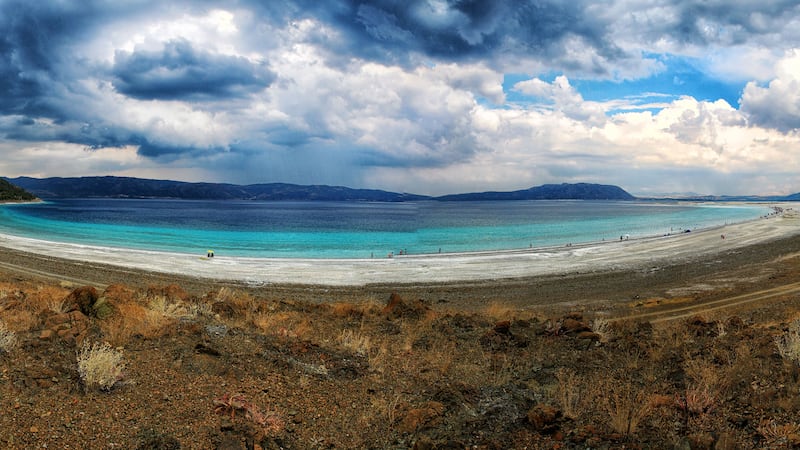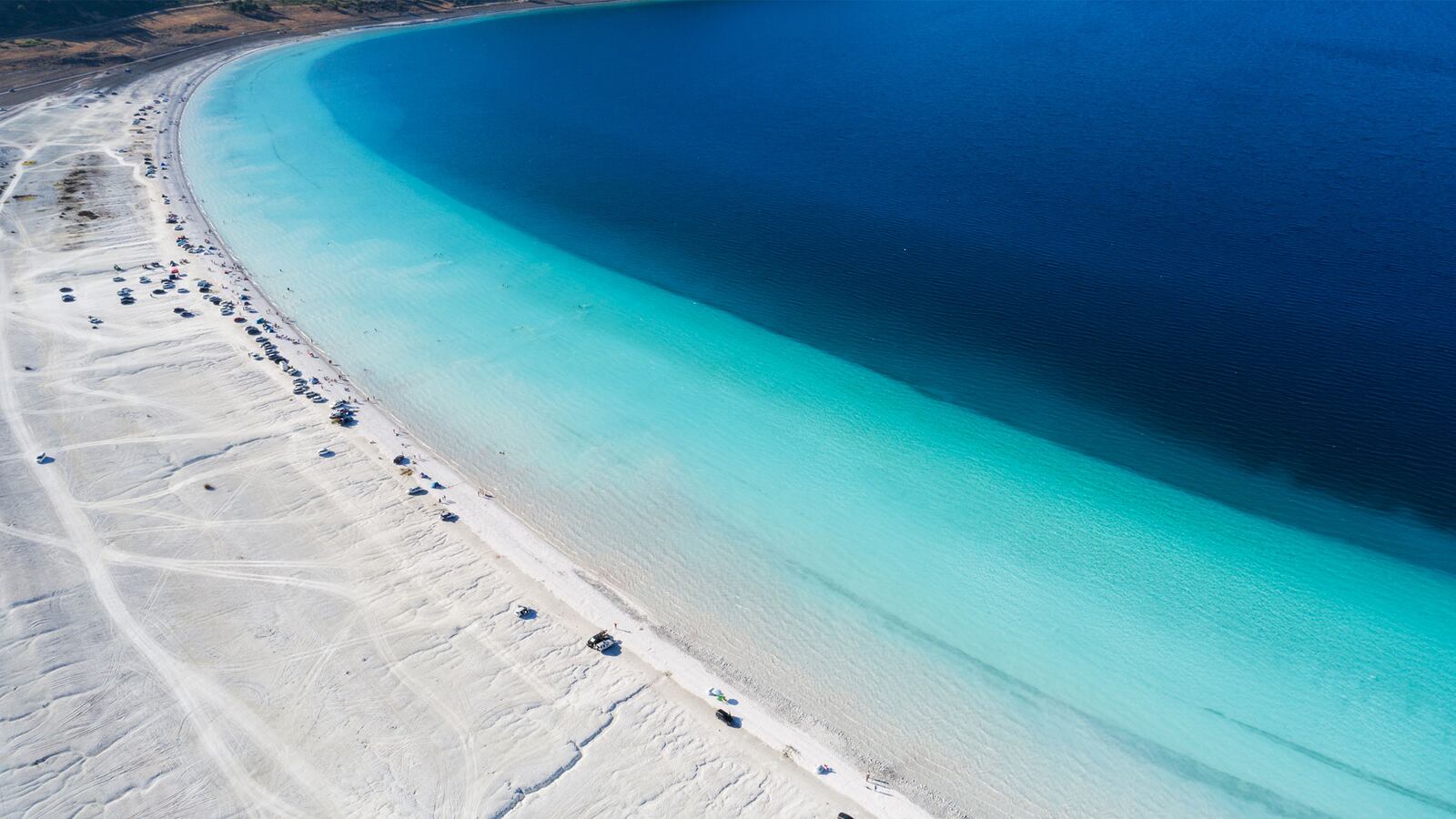Yaǧmur Güneş wanted to study Mars. On an exchange year spent in the U.S., she’d encountered the concept of planetary geology and was completely fascinated. “I didn’t know that I could practice geology beyond Earth,” says Güneş. Soon, she shifted her science studies to focus on Martian analogs, places on Earth that share physical or geological features with the red planet.
“Whatever I’m working on, I’m always trying to make connections about Mars, trying to understand what I know, thinking about Mars,” she says.
“I think it’s very interesting to try to understand a planet that I’m not living on, especially Mars,” says Güneş, “because it is known that Mars and the Earth were very alike. They are like sisters and twins, like brothers.”
When she returned to her studies in Turkey as a PhD student in geomicrobiology at Istanbul Technical University, it turned out that Güneş was ideally positioned to study a planet millions of miles away.
“There was a headline [in our department] that said, if you’re curious about Mars, go to Lake Salda.”
Lake Salda, a freshwater lake located in the southwest of Turkey, has always been striking for its unusual beauty. Nicknamed “the Maldives of Turkey” thanks to its unusual white sand and water that dances between deep navy blue and turquoise, Lake Salda has drawn visitors in the past who were eager to swim in the clear water, walk or camp on the white shore, and admire the unusual formations at the Beyaz Adalar section of the lakefront. But in August of 2019, the lake drew a different kind of visitor: NASA.
It turns out that Lake Salda is the only known lake on Earth to share features with Mars’ Jezero Crater, where NASA landed the Perseverance Rover in February 2021. In anticipation of that mission, NASA dispatched a team of U.S.- and Turkey-based scientists to do fieldwork at Lake Salda, a team that included Yaǧmur Güneş. By studying the geology and mineralogy of Lake Salda, NASA researchers were able to gain insight into the potential layout—and potential traces of life—at the Jezero Crater. When NASA announced the connection between Lake Salda and Jezero Crater, a lake that was little known outside of Turkey quickly found itself thrust into international prominence.
Turkish news sites trumpeted the lake’s extraterrestrial connection. NASA published blog posts about the successful rover launch’s connection to Anatolia. But the attention highlighted a conflict that had been simmering under the surface about tourism, environmentalism, development, and the government.

The main tourism attraction at Lake Salda has always been Beyaz Adalar, the whitest stretch of beach with pillowy white rock structures that rise above the lake. It’s also been the main draw for scientists. Beyaz Adalar feels like a lush moonscape, blazing white with stones that look like bleached brains, or discarded coral. The structures where the NASA scientists study are rough white protrusions that used to be covered with water. Those structures contain geological clues about Lake Salda, and by extension, about Mars.
“Lake Salda is very important in terms of its unique hydro-geological formations,” says Dr. Sedat Kalem, conversation director of World Wildlife Fund Turkey. “The current forms of cyanobacteria, which are considered as the first life forms on Earth, are still active here. It is a rare example, which imposes a big responsibility of meticulously protecting this heritage on our shoulders.”
Until recently, tourists could swim in the Beyaz Adalar part of the lake, climb on the structures, and camp on the beach. But that changed with a controversial government initiative to redevelop Lake Salda in a way that promotes tourism while protecting the environment.
Alperen Kerkuklu is the project site control engineer for the Salda Lake Conservation Project, which launched in 2019. At that time, the lake was designated a special protected site at the highest levels of government, and plans were made to both protect the nature and control the desired influx of tourists. Kerkuklu helped design the new plan for Lake Salda, with an eye towards minimizing the previous damage tourists were doing to the environment without shutting down tourism completely.
The development plan from the government shut down many of the businesses that had sprung up along the lake, replacing them with kiosks that will sell souvenirs and Turkish snacks like gozleme, a savory crepe. Raised wooden walkways have been put in place to guide visitors, and wooden boundaries along the shore have been set up to prevent cars from driving directly to the water’s edge. Instead, there is a new parking lot two kilometers away from Beyaz Adalar, and an electric trolley to ferry visitors to the beach. New buildings that will contain restaurants and facilities have also been built.
“We need to do this to control the tourists,” says Kerkuklu, “Otherwise, if you don't do this project, everybody will attack the lake.”
The project has been greeted skeptically by environmentalists and a community that has learned to be wary of government development projects. There is precedent for their skepticism, as nature and heritage have often been the casualty of development in Turkey, from the attempted destruction of Istanbul’s Gezi Park that launched nationwide anti-government protests in 2013, to the submersion of the historic town of Hasankeyf, to recent controversial development in the Black Sea province of Rize. Feryal Cevikoz, a journalist and activist who started a petition to protect Lake Salda, summed up a common line of thought about these sort of environmentally disruptive projects: “If the government is doing something, I can’t believe that it’s going to be something good.”
However, Kerkuklu’s design tries to balance the need to protect nature and tourism.
Before the project began in 2019, cars could drive up to the edge of the water and people commonly barbecued, smoked, and camped on the beach, inevitably leaving their litter behind. Now, Beyaz Adalar is almost completely blocked off and the beach has been mostly cleared of human litter, while those who wish to swim can go to other sections of the lake, including the Halk Plaji beach. The only way to see any of the Beyaz Adalar side of the lake is to take an electric trolley from the designated parking lot to a tiny spit of white beach two kilometers away, where tourists can pose next to two bright blue “SALDA” signs and see the lake as a background, in the distance. Boundary ropes and posts are supposed to prevent tourists from going to the lake.

How effective these restrictions will be is still a question. Over the Eid al-Adha holiday in July, five people were fined for vandalizing the lake by taking mud baths and smoking, two things that are prohibited. Signs and wooden barriers can only do so much to protect a lake that visitors feel entitled to enjoy any way they like.
Incidents like this contribute to the feeling that tourism shouldn’t be allowed at the lake at all, at least not in its current form. Mustafa Şahin is a lawyer registered with the Antalya Bar Association, and he is one of the lawyers who filed a case to stop the government development at Lake Salda. He believes that blocking off access to Beyaz Adalar is not enough to protect the delicate ecosystem of the lake.
“This area should be opened to visitors with the meticulousness of a museum. And it should be evaluated as a research center and taken under protection,” says Şahin. “Access to the lake should be prohibited, and walking on the white dunes should be prohibited.”
Dr. Kalem believes a more sustainable form of tourism could protect the environment at Lake Salda. “Visitation should be limited as per carrying capacity and focus more on educational activities rather than overusing it for smokey picnic or swimming,” he says. “Again, effective management, protection and good monitoring are crucial for a sustainable outcome.”
Even as the project nears completion, the tension remains. Kerkuklu was attacked by two locals in June who disagreed with his work at Lake Salda. Perhaps it won’t be possible to bridge the communication divide in a country that is so polarized and mistrustful of government projects, or to find the balance between allowing tourism and protecting nature.
But these days, Beyaz Adalar is blissfully quiet, with the people-free beach stretching out in an endless ribbon of white. The sky is filled with the soft chirp of birds and tiny clusters of small silver fish dart through the clear turquoise water, no longer disturbed by humans.
Güneş, the scientist, thinks that it should be possible to both protect and enjoy Lake Salda, as long as the unique structures at Beyaz Adalar are safe. “There has to be a time and place for all the tourists’ visits,” says Güneş. “I don’t think it should all be banned, because—it’s not a professional opinion—I just don’t like the idea of banning people from somewhere very beautiful just because it’s scientifically interesting.”

